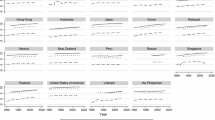Abstract
In this study, we examine the energy intensity convergence in OECD countries within the context of recent developments in unit root analysis by paying attention to modeling structural shifts. We collect the total primary energy consumption/GDP data of 27 OECD countries during the period 1980–2014. The findings indicate that controlling for shifts plays a crucial role, and different approximations in modeling breaks lead to changes in inferences. In conclusion, we present some policy proposals.
Similar content being viewed by others
Notes
The inferences of standard methods are valid under these conditions: the economies must have identical first-order autoregressive dynamic structures and all explanatory variables control for all permanent cross-country differences.
References
Adhikari D, Chen Y (2014) Energy productivity convergence in Asian countries: a spatial panel data approach. Int J Econ Finance 6:94–107
Apergis N, Christou C (2016) Energy productivity convergence: new evidence from club converging. Appl Econ Lett 23:142–145
Ardakani FJ, Ardehali MM (2014) Long-term electrical energy consumption forecasting for developing and developed economies based on different optimized models and historical data types. Energy 65:452–461
Barro RJ, Sala-i Martin X (1991) Convergence across states and regions. Brook Pap Econ Activity 1991(1):107–158
Barro RJ, Sala-i Martin X (1992) Convergence. J Political Econ 100:223–251
Barro RJ, Sala-i Martin X (1995) Economic growth. Mc Graw Hill, New York
Bergaentzle C, Clastres C, Khalfallah H (2014) Demand-side management and European environmental and energy goals: an optimal complementary approach. Energy Policy 67:858–869
Bernard AB, Durlauf SN (1995) Convergence in international output. J Appl Econ 10:97–108
Bilgili F, Kocak E, Bulut U, Kuloglu A (2017a) The impact of urbanization on energy intensity: panel data evidence considering cross-sectional dependence and heterogeneity. Energy 133:242–256
Bilgili F, Kocak E, Bulut U, Kuskaya S (2017b) Can biomass energy be an efficient policy tool for sustainable development? Renew Sust Energ Rev 71:830–845
British Petroleum (2017) BP statistical review of world energy, June 2016. https://www.bp.com/content/dam/bp/pdf/energy-economics/statistical-review-2016/bp-statistical-review-of-world-energy-2016-full-report.pdf. Accessed 4 April 2017
Burnett JW, Madariaga J (2017) The convergence of US state-level energy intensity. Energy Econ 62:357–370
Carlino GA, Mills LO (1993) Are US regional incomes converging? A time series analysis. J Monet Econ 32:335–346
Dickey DA, Fuller WA (1981) Likelihood ratio statistics for autoregressive time series with a unit root. Econom 49:1057–1072
Elliott RJR, Sun P, Zhu T (2014) Urbanization and energy intensity: a province-level study for China. Univ Birm Dep Econ Discuss Pap 14–05. https://www.birmingham.ac.uk/Documents/college-social-sciences/business/economics/2014-discussion-papers/14-05.pdf. Accessed 2 August 2017
Enders W, Lee J (2012) The flexible Fourier form and Dickey–Fuller type unit root tests. Econ Lett 117:196–199 ZZ
Energy Information Administration (2005) Policies to promote non-hydro renewable in the United States and selected countries. https://permanent.access.gpo.gov/lps89097/nonhydrorenewablespaper_final.pdf. Accessed 31 May 2017
Energy Information Administration (2014) Electric utility demand side management. https://www.eia.gov/electricity/data/eia861/dsm/. Accessed 1 June 2017
Energy Information Administration (2017) International Energy Statistics. https://www.eia.gov/. Accessed 30 April 2017
Evans P (1996) Using cross-country variances to evaluate growth theories. J Econ Dyn Cont 20:1027–1049
Ezcurra R (2007) Distribution dynamics of energy intensities: a cross-country analysis. Energy Policy 35:5254–5259
Fischer C, Newell RG (2008) Environmental and technology policies for climate mitigation. J Environ Econ Manag 55:142–162
Galinato GI, Yoder JK (2010) An integrated tax-subsidy policy for carbon emission reduction. Resour Energy Econ 32:310–326
Herrerias MJ (2012) World energy intensity convergence revisited: a weighted distribution dynamics approach. Energy Policy 49:383–399
Karimu A, Brannlund R, Lundgren T, Soderholm P (2017) Energy intensity and convergence in Swedish industry: a combined econometric and decomposition analysis. Energy Econ 62:347–356
Le Pen Y, Sevi B (2010) On the non-convergence of energy intensities: evidence from a pair-wise econometric approach. Ecol Econ 69:641–650
Liddle B (2010) Revisiting world energy intensity convergence for regional differences. Appl Energy 87:3218–3225
Madlener R, Sunak Y (2011) Impacts of urbanization on urban structures and energy demand: what can we learn for urban energy planning and urbanization management? Sustain Cities Soc 1:45–53
Markandya A, Pedroso-Galinato S, Streimikiene D (2006) Energy intensity in transition economies: is there convergence towards the EU average? Energy Econ 28:121–145
Mulder P, de Groot HL (2012) Structural change and convergence of energy intensity across OECD countries, 1970–2005. Energy Econ 34:1910–1921
Narayan PK, Popp S (2010) A new unit root test with two structural breaks in level and slope at unknown time. J Appl Stat 37:1425–1438
Perron P (1989) The great crash, the oil price shock, and the unit root hypothesis. Econom 57:1361–1401
Pesaran MH (2007) A pair-wise approach to testing for output and growth convergence. J Econom 138:312–355
Quah DT (1993) Galton’s fallacy and tests of the convergence hypothesis. Scand J Econ 95:427–443
Reiche D, Bechberger M (2004) Policy differences in the promotion of renewable energies in the EU member states. Energy Policy 32:843–849
World Bank (2017) World Bank Open Data. http://data.worldbank.org/. Accessed 1 June 2017
Zivot E, Andrews DWK (1992) Further evidence on the great crash, the oil-price shock, and the unit-root hypothesis. J Bus Econ Stat 10:251–270
Zoundi Z (2017) CO2 emissions, renewable energy and the Environmental Kuznets Curve, a panel cointegration approach. Renew Sust Energ Rev 72:1067–1075
Author information
Authors and Affiliations
Corresponding author
Additional information
Responsible editor: Philippe Garrigues
Appendix
Appendix
Energy intensity levels of the countries in the sample

Rights and permissions
About this article
Cite this article
Bulut, U., Durusu-Ciftci, D. Revisiting energy intensity convergence: new evidence from OECD countries. Environ Sci Pollut Res 25, 12391–12397 (2018). https://doi.org/10.1007/s11356-018-1551-z
Received:
Accepted:
Published:
Issue Date:
DOI: https://doi.org/10.1007/s11356-018-1551-z




